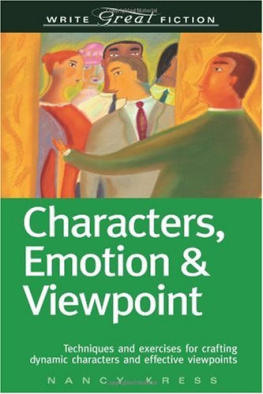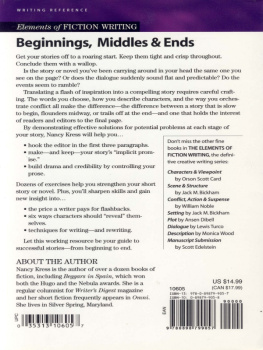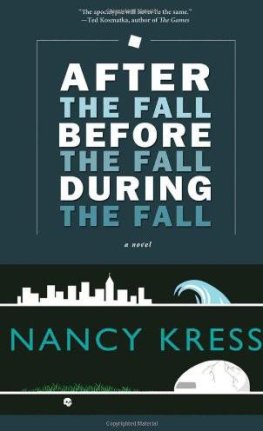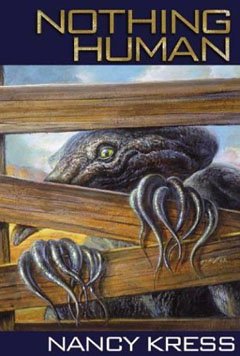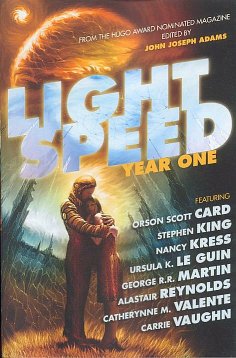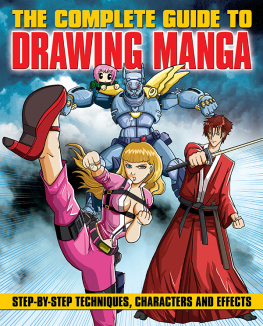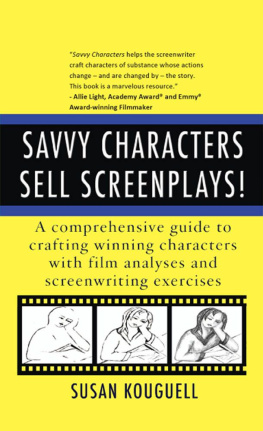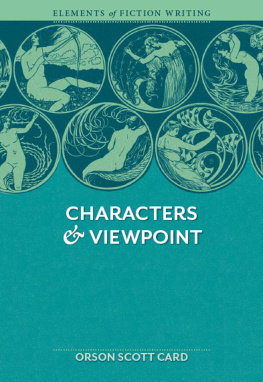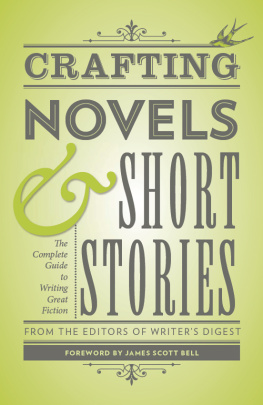Nancy Kress - Characters, Emotion and Viewpoint: Techniques and exercises for crafting dynamic characters and effective viewpoints
Here you can read online Nancy Kress - Characters, Emotion and Viewpoint: Techniques and exercises for crafting dynamic characters and effective viewpoints full text of the book (entire story) in english for free. Download pdf and epub, get meaning, cover and reviews about this ebook. year: 2011, genre: Art. Description of the work, (preface) as well as reviews are available. Best literature library LitArk.com created for fans of good reading and offers a wide selection of genres:
Romance novel
Science fiction
Adventure
Detective
Science
History
Home and family
Prose
Art
Politics
Computer
Non-fiction
Religion
Business
Children
Humor
Choose a favorite category and find really read worthwhile books. Enjoy immersion in the world of imagination, feel the emotions of the characters or learn something new for yourself, make an fascinating discovery.
- Book:Characters, Emotion and Viewpoint: Techniques and exercises for crafting dynamic characters and effective viewpoints
- Author:
- Genre:
- Year:2011
- Rating:4 / 5
- Favourites:Add to favourites
- Your mark:
- 80
- 1
- 2
- 3
- 4
- 5
Characters, Emotion and Viewpoint: Techniques and exercises for crafting dynamic characters and effective viewpoints: summary, description and annotation
We offer to read an annotation, description, summary or preface (depends on what the author of the book "Characters, Emotion and Viewpoint: Techniques and exercises for crafting dynamic characters and effective viewpoints" wrote himself). If you haven't found the necessary information about the book — write in the comments, we will try to find it.
Nancy Kress: author's other books
Who wrote Characters, Emotion and Viewpoint: Techniques and exercises for crafting dynamic characters and effective viewpoints? Find out the surname, the name of the author of the book and a list of all author's works by series.
Characters, Emotion and Viewpoint: Techniques and exercises for crafting dynamic characters and effective viewpoints — read online for free the complete book (whole text) full work
Below is the text of the book, divided by pages. System saving the place of the last page read, allows you to conveniently read the book "Characters, Emotion and Viewpoint: Techniques and exercises for crafting dynamic characters and effective viewpoints" online for free, without having to search again every time where you left off. Put a bookmark, and you can go to the page where you finished reading at any time.
Font size:
Interval:
Bookmark:


CHAPTER ONE:
Types of CharactersAssembling Your Cast
CHAPTER TWO:
Introducing CharactersFirst Impressions Count
CHAPTER THREE:
The Genuine SelfWhat Is She Really Like?
CHAPTER FOUR:
The Motivationally Complicated CharacterBut I 'm a Mess Inside!
CHAPTER FIVE:
Showing Change in Your CharactersIf I Knew Then
What I Know Now
CHAPTER SIX:
Protagonists in Genre FictionFrom Lovers to Starship Captains
CHAPTER SEVEN:
The Humorous CharacterAll Bets Are Off
CHAPTER EIGHT:
Talking About EmotionDialogue and Thoughts
CHAPTER NINE:
Emotion SuggestedUsing Metaphor, Symbol, and
Sensory Details to Convey Feeling
CHAPTER TEN:
Special Cases of EmotionLoving, Fighting, and Dying
CHAPTER ELEVEN:
FrustrationThe Most Useful Emotion in Fiction
CHAPTER TWELVE:
Point of ViewWhose Emotions Are We Sharing?
CHAPTER THIRTEEN:
First PersonI Saw It With My Own Eyes
CHAPTER FOURTEEN:
Third PersonSee Dick Run
CHAPTER FIFTEEN:
Omniscient Point of ViewPlaying God
CHAPTER SIXTEEN:
Putting It All TogetherThe Fourth Persona
APPENDIX:
ChecklistCritical Points

Every dramaand fiction is always a kind of dramarequires a cast. The cast may be so huge, as in Leo Tolstoy's Anna Karenina, that the author or editor provides a list of characters to keep everybody straight. Or it may be an intimate cast of two. (In "To Build a Fire," Jack London managed with one person and a dog.) Whatever the size of your cast, you have to assemble it from somewhere.
Where do you get these people? And how do you know they'll make good characters?
You have four sources: yourself, real people you know, real people you hear about, and pure imagination.

In one sense, every character you create will be yourself. You've never murdered, but your murderer's rage will be drawn from memories of your own most extreme anger. Your love scenes will use your own past kisses, caresses, and sweet moments. That scene in which your octogenarian feels humiliated will draw on your experience of humiliation in the eighth grade, even though the circumstances are totally different and you're not even consciously thinking about your middle-school years. Our characters' emotions draw on our own emotions. Until telepathy is common, our own emotions are the only ones we've intimately experienced. They're our default setting.
Sometimes, however, you will want to use your life more directly in your fiction, dramatizing actual incidents. This has both strengths and pitfalls.
The strength is that you were there. You know the concrete details and can get them right: the way the light slants through a church window at noon, the smell of cooking fat in a diner, the dialogue of cops in the precinct house. These things are invaluable in creating believable fiction.
Even more important, you were there emotionally. You felt whatever exaltation, fear, panic, tenderness, or despair the situation evoked. A well-done biographical incident can therefore have tremendous fictional power. That's why so many successful writers have drawn directly on their own lives for their work.
Charles Dickens used his desperate stint as a child laborer in Victorian England to write David Copperfield. John Galsworthy, like his character Jolyon Forsyte of The Forsyte Saga, had an affair with and later married the wife of his abusive cousin. Nora Ephron, best-selling author of Heartburn, was frank about basing her story of adultery and desertion on her own desertion by husband Carl Bernstein (fiction as public revenge).
Should you create a protagonist based directly on yourself? The problem with thisand it is a very large problemis that almost no one can view himself objectively on the page. As the writer, you're too close to your own complicated makeup. This makes it very difficult to use that third mind-set (see the introduction) and become the reader, who doesn't know that the character's nastiness in the first scene is actually balanced by your admirable sense of fair play. You know it, and you'll bring it out later in the story... but by that time it may be too late. The reader only knows what's on the page, not what's in your mind and heart.
It can thus be easier and more effective to use the situation or incident from your life but make it happen to a character who is not you. In fact, that's what the authors cited above have largely done. Rachel Samstat, Nora Ephron's heroine, is sassier and funnier when left by her husband than any real person would be. You can still, of course, incorporate aspects of yourself: your love of Beethoven, your quick temper, your soccer injuries. But by using your own experience with a different protagonist, you can take advantage of your insider knowledge of the situation, and yet gain an objectivity and control that the original intense situation, by definition, did not have.
So where do you get this other protagonist?

Many, many famous characters are based, in part, on real people. The key words here are "in part."
Question:
If I base a fictional character on the life of my crazy sister, can she sue me?
Answer:
In the United States, anyone can file a lawsuit against anyone else. Whether your sister could win a lawsuit against you for using her in your fiction is another story. Some things to consider:
Is your sister a public figure? If so, she has little protection. Courts have ruled that public figures may be satirized without penalty. In his novel Libra, for instance, Don DeLillo made mincemeat of Richard M. Nixon.
Is your sister extremely famous? If so, courts may consider that she has "rights of publicity" to her own life, meaning that she, not you, owns the right to gain the publicity from publishing her story. This has been a court ruling mainly in California.
Have you invaded your sister's privacy? If all you've done is create a character who, like your sister, has three shoplifting convictions and four marriages, these things are matters of public record. She has no case based on invasion of privacy.
Is what you wrote true? If so, you are safe from defamation and libel. Both must contain untrue allegations to be proved.
And, finallyhow much do you care if your sister never speaks to you again?
Like characters based on yourself, fictional creations based on others seem to be most effective when they're cannibalized. Using people straight can, as in the case of using yourself, limit both imagination and objectivity. So instead of using your Uncle Jerome exactly as he is, consider combining his salient traits with those of other acquaintances or with purely made-up qualities. This has several advantages.
First, you can craft exactly the character you need for your plot. Suppose, for instance, that your actual Uncle Jerome is quick-tempered and cuttingly witty when angered and remorseful later about the terrible (but very funny) things he said while mad. But your character would work better if he were a stranger to remorse, staying angry in a cool, unrepentant way. Combine Uncle Jerome with your friend Don, who can hold a grudge until
Font size:
Interval:
Bookmark:
Similar books «Characters, Emotion and Viewpoint: Techniques and exercises for crafting dynamic characters and effective viewpoints»
Look at similar books to Characters, Emotion and Viewpoint: Techniques and exercises for crafting dynamic characters and effective viewpoints. We have selected literature similar in name and meaning in the hope of providing readers with more options to find new, interesting, not yet read works.
Discussion, reviews of the book Characters, Emotion and Viewpoint: Techniques and exercises for crafting dynamic characters and effective viewpoints and just readers' own opinions. Leave your comments, write what you think about the work, its meaning or the main characters. Specify what exactly you liked and what you didn't like, and why you think so.

